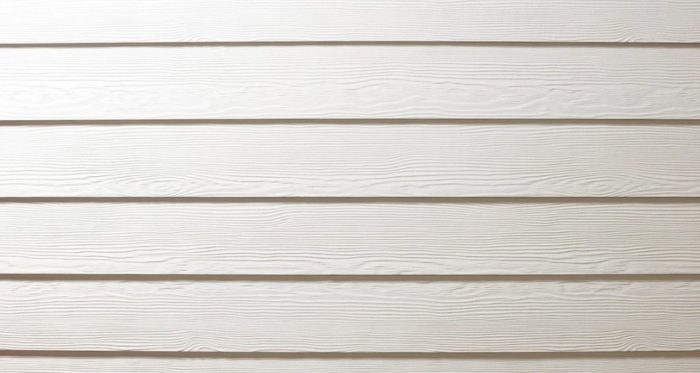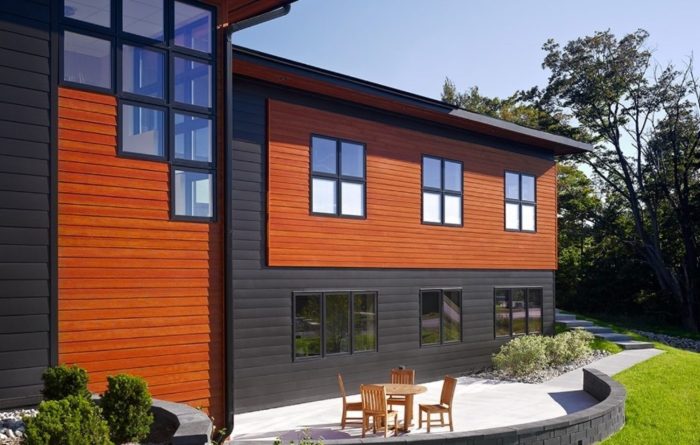Insulated Siding for Noise Reduction: A Quieter Life – dreaming of a peaceful sanctuary away from the city’s cacophony? Imagine a home where the sounds of traffic fade into a gentle hum, replaced by the quiet rustle of leaves. This isn’t a fantasy; it’s the promise of insulated siding, a game-changer in home acoustics. We’ll dive into how this innovative technology works, exploring its benefits, different types, and how it can transform your living space into an oasis of calm.
From understanding the sources and effects of noise pollution to exploring the technical aspects of insulated siding, we’ll unpack everything you need to know. We’ll compare different materials, delve into installation techniques, and even analyze the long-term cost-effectiveness. Get ready to discover how insulated siding can not only improve your home’s soundproofing but also enhance its energy efficiency, leading to a more comfortable and peaceful life.
Introduction: Insulated Siding For Noise Reduction: A Quieter Life

Noise pollution, the pervasive presence of unwanted or excessive sound, significantly impacts our daily lives and well-being. It’s a silent threat, often underestimated, that affects millions worldwide, impacting not only our hearing but also our overall health and mental state. Understanding its sources and consequences is crucial to mitigating its effects and creating healthier, quieter living environments.The sources of noise pollution affecting homes are diverse and often unavoidable in modern society.
Traffic noise, whether from busy roads or nearby highways, is a primary culprit. Construction projects, both large-scale developments and smaller renovations, generate significant noise disturbances. Air and rail traffic, especially near airports and train lines, contribute substantially to ambient noise levels. Even seemingly minor sources, such as noisy neighbors, barking dogs, and loud appliances, can cumulatively create a stressful soundscape.
The constant hum of industrial activity in proximity to residential areas further adds to the problem.
Negative Health and Psychological Effects of Noise Pollution, Insulated Siding for Noise Reduction: A Quieter Life
Prolonged exposure to excessive noise has demonstrably negative effects on both physical and mental health. Noise-induced hearing loss, ranging from temporary tinnitus to permanent damage, is a significant concern. Studies have linked chronic noise exposure to cardiovascular problems, including increased blood pressure and heart rate, ultimately increasing the risk of heart disease and stroke. Furthermore, noise pollution negatively impacts sleep quality, leading to fatigue, reduced cognitive function, and impaired concentration.
The constant stress response triggered by unwanted noise can contribute to anxiety, irritability, and even depression. Children are particularly vulnerable, as their developing auditory systems are more susceptible to damage, and their overall health and academic performance can be significantly impacted.
Benefits of a Quieter Living Environment
Creating a quieter living environment offers numerous benefits, positively impacting various aspects of life. Improved sleep quality leads to increased energy levels, enhanced cognitive function, and better overall mood. Reduced stress levels contribute to improved mental health and a decreased risk of stress-related illnesses. A quieter home fosters a more peaceful and relaxing atmosphere, conducive to better concentration and productivity.
This enhanced quality of life translates into increased well-being, improved relationships, and a more enjoyable home environment. For families, a quieter home allows for better communication and creates a more conducive space for learning and relaxation, minimizing distractions and enhancing the overall family dynamic.
Noise Reduction Mechanisms of Insulated Siding

Insulated siding offers a significant advantage over traditional siding materials by incorporating insulation directly into its structure. This design cleverly combines aesthetic appeal with enhanced sound dampening capabilities, creating a quieter and more peaceful living environment. The reduction in noise isn’t just a matter of blocking sound entirely; it’s a complex interplay of several factors working together.
Insulation’s Role in Sound Reduction
The insulation material itself, commonly fiberglass, foam, or mineral wool, plays a crucial role in sound attenuation. These materials are porous and filled with tiny air pockets. When sound waves encounter these materials, the energy of the waves is absorbed and converted into heat, effectively reducing the intensity of the sound that passes through. The effectiveness of the insulation depends on its density and thickness; denser materials with more air pockets generally provide better sound absorption.
Think of it like a sponge absorbing water – the more absorbent the sponge, the less water remains. Similarly, a denser insulation material absorbs more sound energy.
Siding Density and Thickness Influence on Noise Reduction
The density and thickness of the siding itself are also important factors in noise reduction. Denser materials, such as vinyl or fiber cement, are less prone to vibrations caused by sound waves. Thicker siding provides a greater mass that sound waves must penetrate, further reducing transmission. For example, a thicker, denser vinyl siding panel will perform better in noise reduction than a thinner, less dense one.
The increased mass acts as a barrier, preventing sound from easily passing through.
Air Gaps and Design Features Enhancing Sound Dampening
Air gaps within the siding system can further enhance sound reduction. These gaps, often found between the siding and the underlying sheathing, create an impedance mismatch for sound waves. This means that the sound waves struggle to efficiently transfer their energy from one material to the next, resulting in reduced transmission. Additionally, some insulated siding systems incorporate multiple layers or specialized designs that strategically create these air gaps, maximizing their sound-dampening effect.
The design of the siding itself, including its texture and surface irregularities, can also contribute to scattering sound waves and reducing their overall intensity.
Diagram Illustrating Sound Dampening in Insulated Siding
Imagine a cross-section of insulated siding. The exterior layer (dark grey) is the vinyl siding itself. Behind it is a layer of insulation (light grey), which is fiberglass in this example. Then, we have the house wall (beige). Sound waves (represented by red arrows) are approaching from the left.The first barrier is the vinyl siding.
Some sound energy is reflected (smaller red arrows bouncing back). The sound that penetrates the siding encounters the insulation. Here, the sound energy is absorbed and converted to heat (indicated by small, orange circles radiating from the insulation). The remaining sound energy, significantly reduced, then encounters the house wall. The wall acts as a final barrier, absorbing or reflecting the remaining sound energy (represented by even smaller red arrows).
The different shades of grey represent varying densities of the materials, with darker shades indicating denser materials. Labels would clearly indicate each layer: “Vinyl Siding,” “Fiberglass Insulation,” and “House Wall.” The red arrows would be labeled “Incoming Sound Waves,” and the smaller arrows and orange circles would indicate “Reflection” and “Absorption” respectively. The entire diagram would visually demonstrate the gradual reduction of sound energy as it passes through the insulated siding system.
Array
Investing in insulated siding offers more than just aesthetic appeal; it’s a strategic move towards a quieter, more energy-efficient home. While the initial outlay might seem significant, a comprehensive cost-benefit analysis reveals the long-term financial and lifestyle advantages. This section will dissect the financial aspects, comparing the upfront costs with the accruing benefits over time.
Initial Costs of Insulated Siding Installation
The initial cost of installing insulated siding varies greatly depending on several factors. These include the size of your home’s exterior surface area, the type of siding chosen (vinyl, fiber cement, etc.), the complexity of the installation (e.g., existing siding removal), and regional labor costs. A rough estimate for a mid-sized home might range from $10,000 to $25,000 or more.
It’s crucial to obtain multiple quotes from reputable contractors to accurately assess the cost for your specific project. Remember to factor in any necessary permits and additional work, such as repairs to underlying sheathing.
Long-Term Benefits: Noise Reduction and Improved Quality of Life
The quietude afforded by insulated siding translates to tangible improvements in your quality of life. Reduced noise pollution from traffic, neighbors, or other external sources contributes to better sleep, decreased stress levels, and an overall more peaceful home environment. While quantifying these benefits in monetary terms is challenging, studies have linked noise pollution to health problems, highlighting the significant indirect cost savings associated with a quieter living space.
Consider the potential value of improved sleep alone – better rest can lead to increased productivity, improved mood, and a stronger immune system.
Energy Savings from Improved Insulation
Insulated siding acts as an extra layer of insulation, reducing heat transfer in both summer and winter. This leads to significant energy savings by lowering your reliance on heating and cooling systems. The amount of energy saved will depend on your climate, the existing insulation in your walls, and the R-value of the chosen siding. For example, a homeowner in a region with extreme temperature fluctuations might see a reduction in their energy bills by 15-20% or more annually.
This translates to substantial long-term savings, offsetting a portion of the initial investment.
Ten-Year Cost-Benefit Analysis
The following table provides a simplified example of a ten-year cost-benefit analysis. Remember that actual figures will vary depending on your specific circumstances. This example assumes a $15,000 initial cost, $1,000 annual energy savings, and doesn’t include the intangible benefits of noise reduction and improved quality of life.
| Year | Initial Cost | Energy Savings | Net Benefit |
|---|---|---|---|
| 0 | -$15,000 | $0 | -$15,000 |
| 1 | $0 | $1,000 | -$14,000 |
| 2 | $0 | $1,000 | -$13,000 |
| 3 | $0 | $1,000 | -$12,000 |
| 4 | $0 | $1,000 | -$11,000 |
| 5 | $0 | $1,000 | -$10,000 |
| 6 | $0 | $1,000 | -$9,000 |
| 7 | $0 | $1,000 | -$8,000 |
| 8 | $0 | $1,000 | -$7,000 |
| 9 | $0 | $1,000 | -$6,000 |
| 10 | $0 | $1,000 | -$5,000 |
Ultimately, the pursuit of a quieter life is a journey towards better well-being. Insulated siding presents a compelling solution, offering a blend of noise reduction, energy efficiency, and aesthetic appeal. While it might not eliminate every sound, the significant improvement it provides in reducing external noise pollution is undeniable. By understanding the different types of siding, considering factors like installation and maintenance, and weighing the long-term cost-benefit analysis, you can make an informed decision about transforming your home into a tranquil haven.
So, take the first step towards a quieter, more peaceful life – explore the possibilities of insulated siding today!
FAQs
What are the common signs that my home needs better sound insulation?
Difficulty concentrating due to outside noise, consistently disturbed sleep, loud conversations easily heard from other rooms, or excessive street noise are all signs.
Can insulated siding completely eliminate all outside noise?
No, it significantly reduces noise, but it won’t eliminate it entirely. The level of noise reduction depends on factors like the type of siding, installation, and the severity of the external noise.
How does the R-value of insulated siding relate to noise reduction?
While R-value primarily measures thermal insulation, a higher R-value often correlates with better sound dampening due to the thicker and denser material, but it’s not a direct measure of noise reduction.
Is insulated siding difficult to maintain?
Maintenance requirements vary by material. Vinyl siding is generally low-maintenance, while fiber cement may require occasional painting or cleaning. Regular inspections for damage are recommended for all types.
How long does insulated siding typically last?
Lifespan varies by material; vinyl siding can last 20-30 years, while fiber cement can last 50 years or more with proper maintenance.